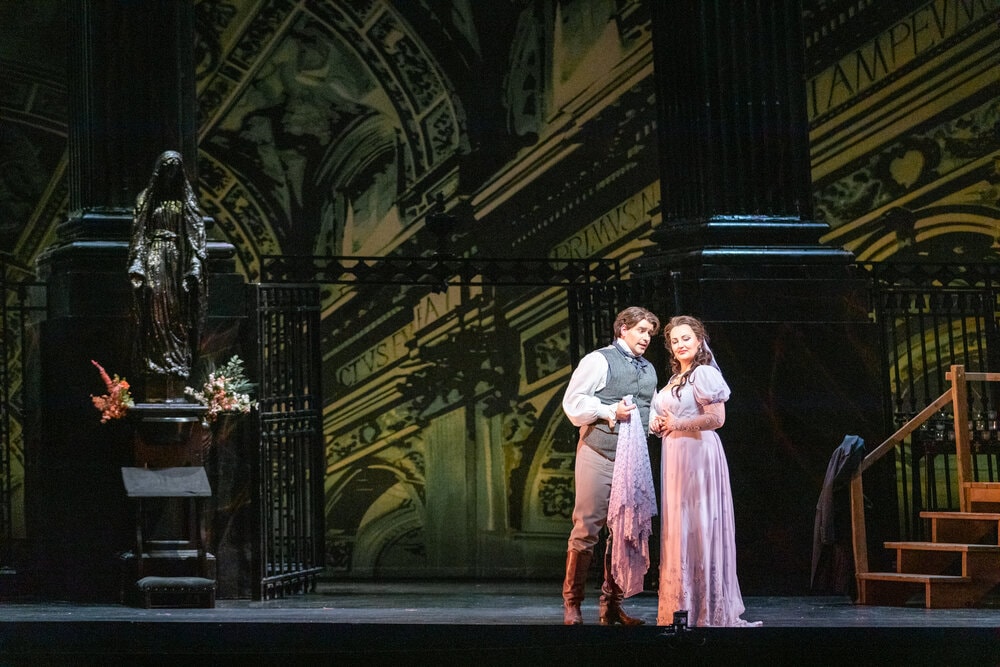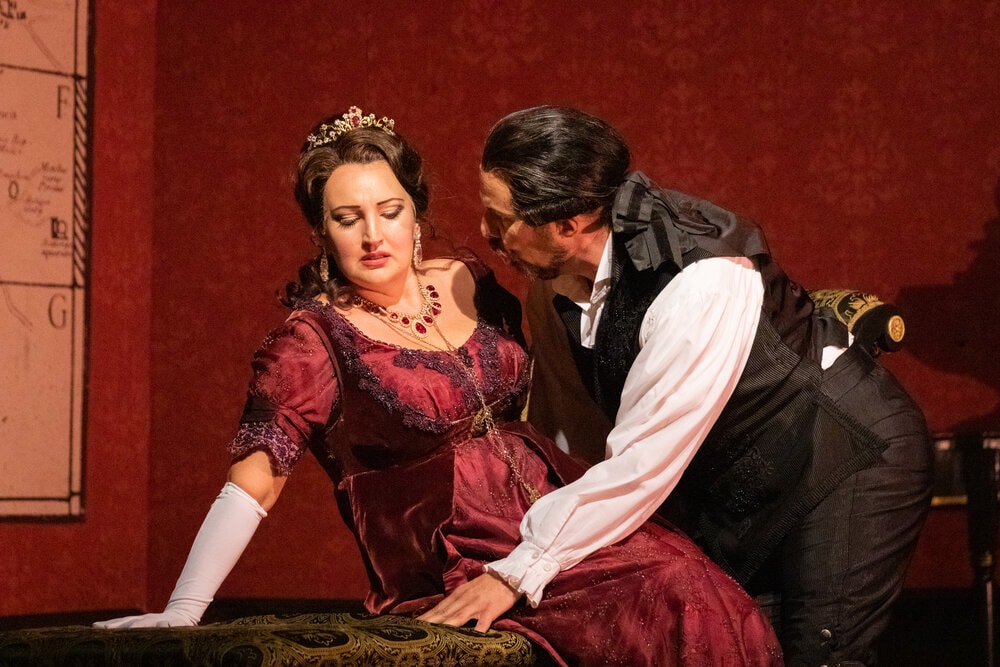The dawn of the 1800s saw a Rome in turmoil. Napoleon Bonaparte spun a soured campaign in Egypt into a public relations success story, securing his legacy as a folk hero and launching a coup d’etat which placed him in the position of First Consul of France. Tosca, penned by the famously apolitical Giacomo Puccini to an Italian libretto by Luigi Illica and Giuseppe Giacosa, explores the lives of those caught in a Roman web of intrigue framed by Napoleon’s approaching victory at the Battle of Marengo.

“Tosca works like clockwork,” writes Director Lillian Groag, “It’s passion driven for all three leading characters and passion is something we pay great homage to, but seldom can allow ourselves to actually feel, especially the romantic/erotic variety, which is by its very definition antisocial.” The three leads: devout singer Floria Tosca (Ewa Płonka), artist Mario Cavaradossi (Matthew Vickers) and the odious Baron Scarpia (Kyle Albertson) comprise the beating heart of this soaring melodrama produced by the Virginia Opera.
Ewa Płonka is a lovely Floria Tosca. Her warm soprano grounds the dramatics required of Tosca in a believably earth piety. As the object of desire for both Cavaradossi and Scarpia, Płonka’s performance—vocal and otherwise—brings a much-needed realism to this role which relies on a singer’s ability to emote boldly in all directions. Despite this opera’s sometimes over-the-top scenarios, it’s difficult not to feel a tug at your heartstrings during Płonka’s rendition of “Vissi d’arte”. Tosca is one of those rare operas where the translations can be as beautiful as the music. This aria showcases that attribute as she sings, sorrowfully:
“Always with sincere faith
my prayer
rose to the holy tabernacles
Always with sincere faith
I gave flowers to the altars
In my hour of sorrow
why, why, Lord
why do you repay me so?”
Aided by Płonka’s depth and tone, Floria Tosca’s unenviable plight at the hands of Baron Scarpia is transformed into something beautiful. This “Vissi d’arte” is one of those performances you’d like to snatch out of the air and hold close before it fades away and disappears completely.
Mario Cavaradossi, portrayed by tenor Matthew Vickers, is Tosca’s lover. At the opening of Act I he is engaged in painting a depiction of Mary Magdalene who, Tosca points out jealously, looks a lot like the Marchesa Attavanti who has recently been to the church to pray. The Marchesa’s visit, along with the appearance of her escaped fugitive brother Cesare Angelotti (Andrew Simpson), is the trigger which involves Tosca and Cavaradossi in the tragic events to follow. Vickers provides a good foil for Płonka, and hits a personal high point during Act III’s famous romantic aria “E lucevan le stelle” singing: Forever, my dream of love has vanished. That moment has fled, and I die in desperation.
Groag’s reflection on the antisocial nature of the work, combined with the staging, lead the audience to consider the nature of love. The beauty of Tosca, and specifically the Virginia Opera’s production, is that the experience of it provides an understanding of our underlying desire to connect to each other. This desire is something we often pursue beyond the bounds of what is socially acceptable. While desire often gives rise to genuine expressions of love which flow equally from two people, it can also lead to dark obsessions which violate the nature of love: enter Kyle Albertson’s Baron Scarpia.

Scarpia’s uncontrolled desire for Tosca leads to much of the suffering in this tale. Bass-baritone Albertson is an effectively sinister villain, declaring “Tosca, you make me forget even God!” during proceeding the Eucharistic procession and Te Deum at the end of Act I. The penultimate scene involving Scarpia and Tosca—which I will not spoil—was one of the better stagings of the event that I have seen portrayed. Scarpia’s lewdness is enhanced in Act II where we see that his apartment at the Palazzo Farnese visually overflows with deep reds, the color perhaps symbolizing a descent into something uncontrolled, with suggestive art hanging from the walls.
Scenic Designer Michael Yeargan gives the audience a lot to chew on throughout. The expanse of the church in Act I is notable for the the broken window above Cavaradossi’s painting. Is the broken church window a symbol of justice and judgement being broken open, with God watching the proceedings impassively? It’s something to consider. Likewise, the statue of the Virgin Mary painted entirely black perhaps suggests a loss of innocence—or a lack of it ever having existed in the first place.
Supporting characters, such as Andrew Simpson’s runaway convict Angelotti and Joshua Arky’s sacristan fill out the corners of the narrative admirably. There isn’t one weak performance in this production. The accompaniment by the Virginia Symphony Orchestra, led by Conductor Adam Turner, is superb.

Tosca is a marvelous entry point for someone interested in acquainting themselves with opera, as well as a great time for those who are already opera fans. The Virgnia Opera’s Tosca is absolutely mesmerizing. Audiences will be enchanted by the strong leads and beloved arias which shine through in this wonderful production of a Puccini classic.
Tosca plays October 18 and October 20, 2019 at the Virginia Opera in the Carpenter Theatre—600 East Grace Street, Richmond, Virginia. Tickets can be purchased online.
(Note: This review is of the October 12, 2019 performance, which took place at the GMU Center for the Arts.)




